Redis实战篇–商户查询缓存
缓存
缓存就是数据交换的缓冲区(称作Cache [ka]),是存数据的临时地方,一般读写性能较高。
缓存的作用
- 降低后端负载
- 提高读写效率
- 降低响应时间
缓存的成本
- 数据一致性成本
- 代码维护成本
- 运维成本
添加redis缓存
将店铺信息存入redis中
主要流程
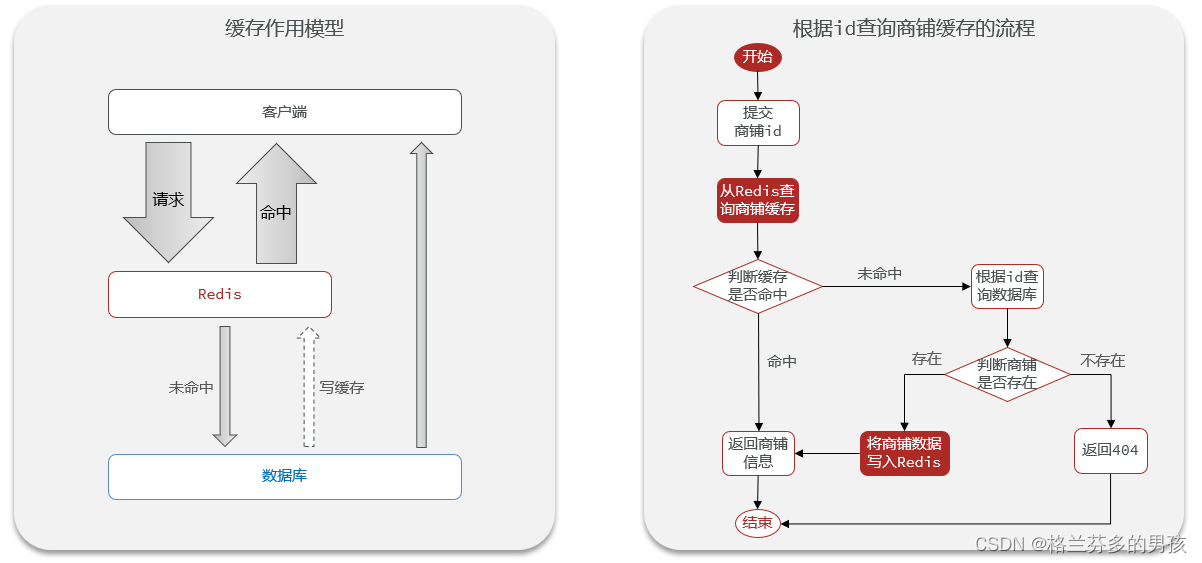 业务代码
业务代码
public Result getShopById(Long id) {
String key = CACHE_SHOP_KEY + id;
//1.从redis查询商铺缓存
String shopJson = stringRedisTemplate.opsForValue().get(key);
//2.是否存在
if(!StringUtil.isNullOrEmpty(shopJson)){
//3.存在 返回商铺信息
Shop shop = JSONUtil.toBean(shopJson, Shop.class);
return Result.ok(shop);
}
//4.不存在根据id在数据库中查询商铺信息
Shop shop = getById(id);
//5.不存在 返回错误信息
if (shop == null) {
return Result.fail("店铺不存在");
}
//6.存在 将商铺信息写入redis中
stringRedisTemplate.opsForValue().set(key,JSONUtil.toJsonStr(shop),RedisConstants.CACHE_SHOP_TTL, TimeUnit.MINUTES);
//7.将商铺信息返回
return Result.ok(shop);
}
作业
给店铺类型查询业务添加缓存

主要思路与上面添加店铺信息缓存相同
- 查询店铺类型在缓存中是否存在
-
存在 直接返回
-
不存在 在数据库中查询商铺类型
- 存在 返回商铺信息列表
- 不存在 报错
-
public List<ShopType> queryShopList() {
//1.在redis中查询是否存在缓存
String key = RedisConstants.CACHE_SHOPlIST_KEY;
List<String> shopList = stringRedisTemplate.opsForList().range(key, 0, -1);
//2.缓存命中 直接返回shopList
if (shopList.size() > 0 ) {
List<ShopType> shopTypeList = shopList.stream().map((list) -> {
ShopType shopType = JSONUtil.toBean(list, ShopType.class);
return shopType;
}).sorted(Comparator.comparing(ShopType::getSort))
.collect(Collectors.toList());
return shopTypeList;
}else {
//3.缓存未命中 则在数据库中查询shopList
List<ShopType> typeList = query().orderByAsc("sort").list();
List<String> strings = typeList.stream().map((shop) -> {
return JSONUtil.toJsonPrettyStr(shop);
}).collect(Collectors.toList());
if(typeList.size() > 0){
//5.存在 写入redis中
stringRedisTemplate.opsForList().leftPushAll(key,strings);
}//6.返回list
return typeList;
}
}
使用缓存与未使用缓存的效果对比

缓存更新策略
缓存更新策略主要有以下三种
| 内存淘汰 | 超时剔除 | 主动更新 | |
|---|---|---|---|
| 说明 | 不用自己维护,利用redus的内存淘汰机制,当内存不足时自动淘汰部分数据,下次查询时更新缓存 | 给缓存数据添加TTL时间,到期后自动删除缓存。下次查询时更新缓存。 | 编写业务逻辑,在修改数据库的同时,更新缓存。 |
| 一致性 | 差 | 一般 | 好 |
| 维护成本 | 无 | 低 | 高 |
业务场景:
- 低一致性需求:使用内存淘汰机制。例如店铺类型的查询缓存
- 高一致性需求:主动更新,并以超时剔除作为兜底方案。例如店铺详情查询的缓存
主动更新策略
Cache Aside Pattern
由缓存的调用者,在更新数据库的同时更新缓存。
Read/Write Through Pattern
缓存与数据库整合为一个服务由服务来维护一致性。调用者调用该服务,无需关心缓存一致性问题。
Write Behind Caching Pattern
调用者只操作缓存,由其它线程异步的将缓存数据持久化到数据库,保证最终一致。
操作缓存和数据库时有三个问题需要考虑
1,删除缓存还是更新缓存?
- 更新缓存:每次更新数据库都更新缓存,无效写操作较多
- 删除缓存:更新数据库时让缓存失效,查询时再更新缓存
2.如何保证缓存与数据库的操作的同时成功或失败?
- 单体系统,将缓存与数据库操作放在一个事务
- 分布式系统,利用TCC等分布式事务方案
先操作缓存还是先操作数据库?
- 先删除缓存,再操作数据库
- 先操作数据库,再删除缓存
缓存更新策略的最佳实践方案
1.低一致性需求:使用Redis自带的内存淘汰机制
2.高一致性需求:主动更新,并以超时剔除作为兜底方案
-
读操作:
- 缓存命中则直接返回
- 缓存未命中则查询数据库,并写入缓存,设定超时时间
-
写操作:
- 先写数据库,然后再删除缓存
- 要确保数据库与缓存操作的原子性
案例
给查询商铺的缓存添加超时剔除和主动更新的策略
修改ShopController中的业务逻辑,满足下面的需求:
① 根据id查询店铺时,如果缓存未命中,则查询数据库,将数据库结果写入缓存,并设置超时时间
public Result getShopById(Long id) {
String key = CACHE_SHOP_KEY + id;
//1.从redis查询商铺缓存
String shopJson = stringRedisTemplate.opsForValue().get(key);
//2.是否存在
if(!StringUtil.isNullOrEmpty(shopJson)){
//3.存在 返回商铺信息
Shop shop = JSONUtil.toBean(shopJson, Shop.class);
return Result.ok(shop);
}
//判断命中的是否是空值
if(shopJson != null){
return Result.fail("店铺不存在2");
}
//4.不存在根据id在数据库中查询商铺信息
Shop shop = getById(id);
//5.不存在 返回错误信息
if (shop == null) {
return Result.fail("店铺不存在1");
}
//6.存在 将商铺信息写入redis中
stringRedisTemplate.opsForValue().set(key,JSONUtil.toJsonStr(shop), CACHE_SHOP_TTL, TimeUnit.MINUTES);
//7.将商铺信息返回
return Result.ok(shop);
}
② 根据id修改店铺时,先修改数据库,再删除缓存.
@Transactional
public Result update(Shop shop) {
Long id = shop.getId();
if(id == null){
return Result.fail("店铺Id不能为空");
}
//1.更新数据库
updateById(shop);
//2.删除缓存
stringRedisTemplate.delete(CACHE_SHOP_KEY+id);
return Result.ok();
}
缓存穿透
缓存穿透是指客户端请求的数据在缓存中和数据库中都不存在,这样缓存永远不会生效,这些请求都会打到数据库。
常见的解决方案有两种:
缓存空对象
- 优点:实现简单,维护方便
- 缺点:
- 额外的内存消耗
- 可能造成短期的不一致
实现流程图
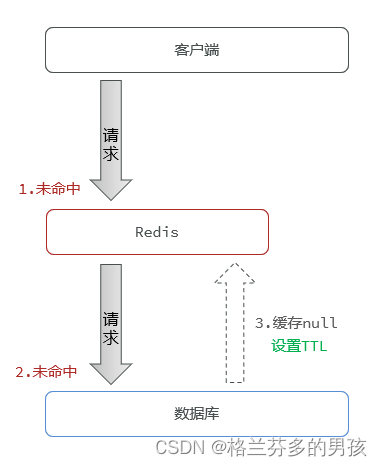
布隆过滤
- 优点:内存占用较少,没有多余key
- 缺点:
- 实现复杂
- 存在误判可能
实现流程图
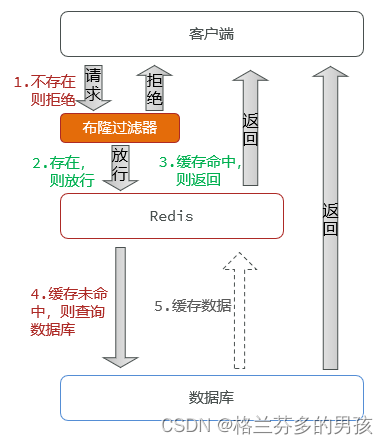
这里采用 缓存空对象进行实践
流程图
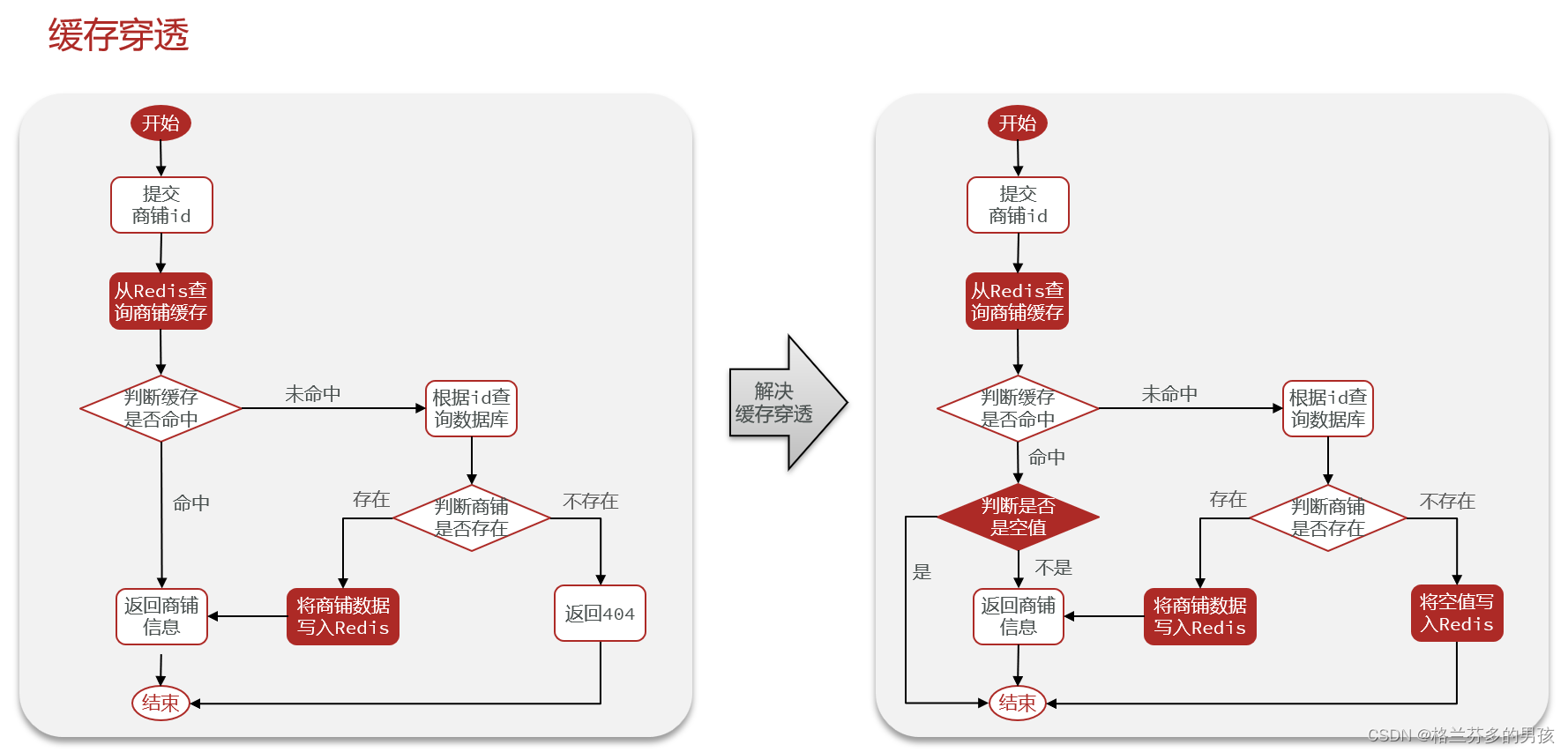
代码
public Result getShopById(Long id) {
String key = CACHE_SHOP_KEY + id;
//1.从redis查询商铺缓存
String shopJson = stringRedisTemplate.opsForValue().get(key);
//2.是否存在
if(!StringUtil.isNullOrEmpty(shopJson)){
//3.存在 返回商铺信息
Shop shop = JSONUtil.toBean(shopJson, Shop.class);
return Result.ok(shop);
}
//判断命中的是否是空值
if(shopJson != null){
return Result.fail("店铺不存在2");
}
//4.不存在根据id在数据库中查询商铺信息
Shop shop = getById(id);
//5.不存在 返回错误信息
if (shop == null) {
stringRedisTemplate.opsForValue().set(key,"",CACHE_NULL_TTL, TimeUnit.MINUTES);
return Result.fail("店铺不存在1");
}
//6.存在 将商铺信息写入redis中
stringRedisTemplate.opsForValue().set(key,JSONUtil.toJsonStr(shop), CACHE_SHOP_TTL, TimeUnit.MINUTES);
//7.将商铺信息返回
return Result.ok(shop);
}
总结
缓存穿透产生的原因是什么?
- 用户请求的数据在缓存中和数据库中都不存在,不断发起这样的请求,给数据库带来巨大压力
缓存穿透的解决方案有哪些?
- 缓存null值
- 布隆过滤
- 增强id的复杂度,避免被猜测id规律
- 做好数据的基础格式校验
- 加强用户权限校验
- 做好热点参数的限流
缓存雪崩
缓存雪崩是指在同一时段大量的缓存key同时失效或者Redis服务宕机,导致大量请求到达数据库,:带来巨大压力。
解决方案:
- 给不同的Key的TTL添加随机值
- 利用Redis集群提高服务的可用性
- 给缓存业务添加降级限流策略
- 给业务添加多级缓存
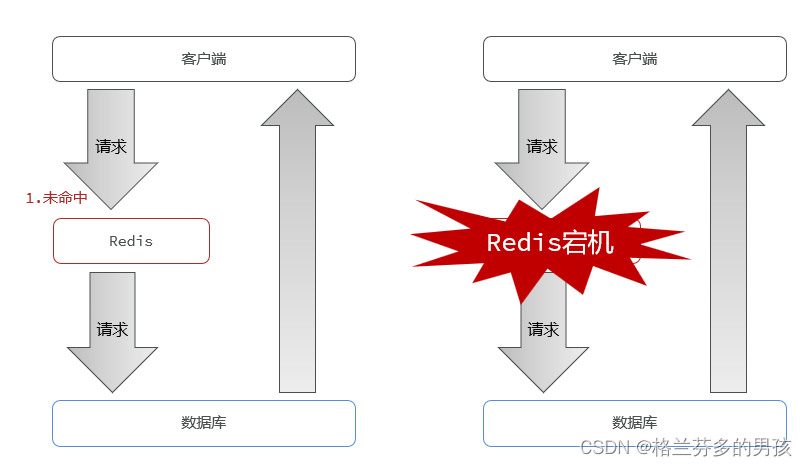
缓存击穿
缓存击穿问题也叫热点Key问题,就是一个被高并发访问并且缓存重建业务较复杂的key突然失效了,无数的请求访问会在瞬间给数据库带来巨大的冲击。
常见的解决方案有两种:
- 互斥锁
- 逻辑过期
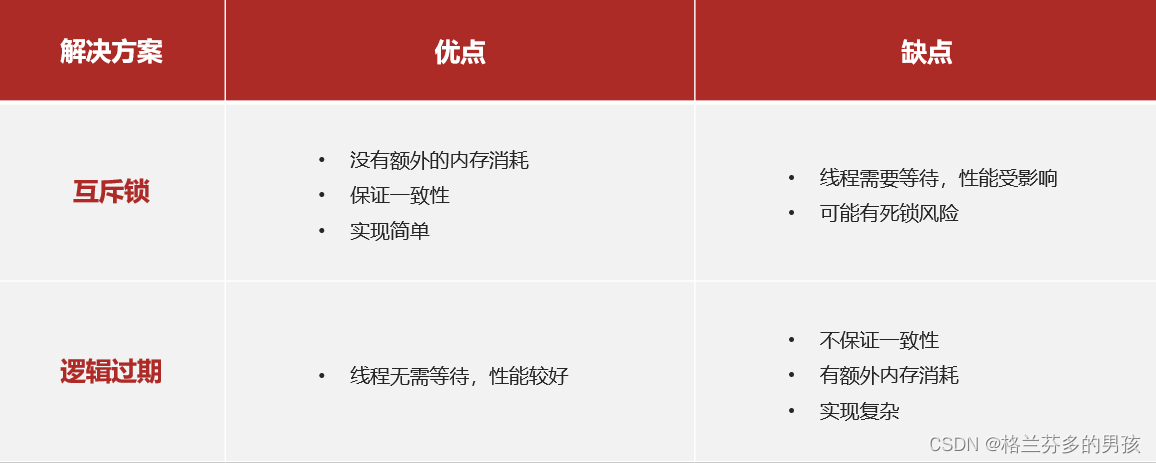
基于互斥锁方式解决缓存击穿问题
业务流程
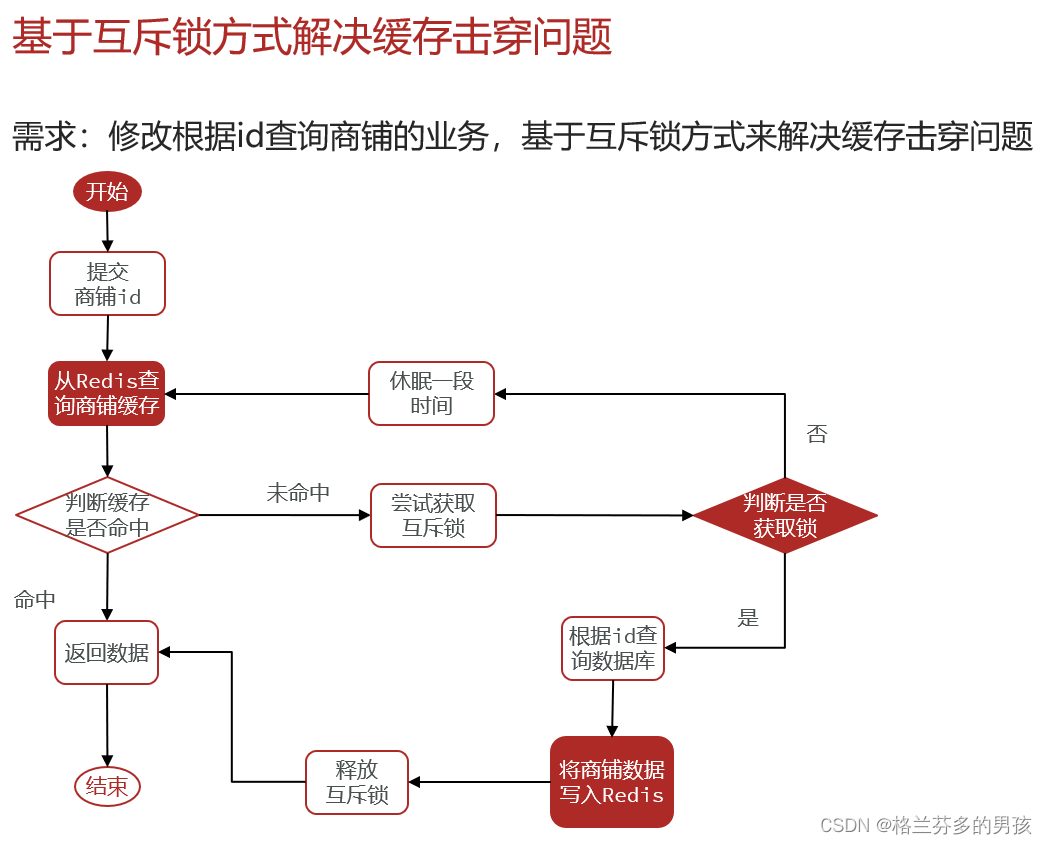
代码:
/**
* 缓存击穿
*
* @param id
* @return
*/
public Shop queryWithMutex(Long id) {
String key = CACHE_SHOP_KEY + id;
//1.从redis查询商铺缓存
String shopJson = stringRedisTemplate.opsForValue().get(key);
//2.是否存在
if (!StringUtil.isNullOrEmpty(shopJson)) {
//3.存在 返回商铺信息
Shop shop = JSONUtil.toBean(shopJson, Shop.class);
return shop;
}
//判断命中的是否是空值
if (shopJson != null) {
return null;
}
//4.实现缓存重建
String lockKey = LOCK_SHOP_KEY + id;
Shop shop = null;
try {
//4.1获取互斥锁
boolean isLock = tryLock(lockKey);
//4.2判断是否成功
if (!isLock) {
//4.3失败,则休眠并重试
Thread.sleep(50);
return queryWithMutex(id);
}
//4.4 再次检查缓存是否存在
String shopJson2 = stringRedisTemplate.opsForValue().get(key);
if (!StringUtil.isNullOrEmpty(shopJson2)) {
//4.5 存在 返回商铺信息
shop = JSONUtil.toBean(shopJson2, Shop.class);
return shop;
}
//查缓存不存在
//4.6成功根据id在数据库中查询商铺信息
shop = getById(id);
//模拟重建延时
Thread.sleep(200);
//5.不存在 返回错误信息
if (shop == null) {
stringRedisTemplate.opsForValue().set(key, "", CACHE_NULL_TTL, TimeUnit.MINUTES);
return null;
}
//6.存在 将商铺信息写入redis中
stringRedisTemplate.opsForValue().set(key, JSONUtil.toJsonStr(shop), CACHE_SHOP_TTL, TimeUnit.MINUTES);
} catch (Exception e) {
throw new RuntimeException(e);
} finally {
//7.释放互斥锁
unLock(lockKey);
}
//8.返回
return shop;
}
/**
* 获取锁
*
* @param key
* @return
*/
private boolean tryLock(String key) {
Boolean flag = stringRedisTemplate.opsForValue().setIfAbsent(key, "1", 10, TimeUnit.SECONDS);
return BooleanUtil.isTrue(flag);
}
/**
* 释放锁
*
* @param key
* @return
*/
private void unLock(String key) {
stringRedisTemplate.delete(key);
}
基于逻辑过期方式解决缓存穿透问题
业务流程
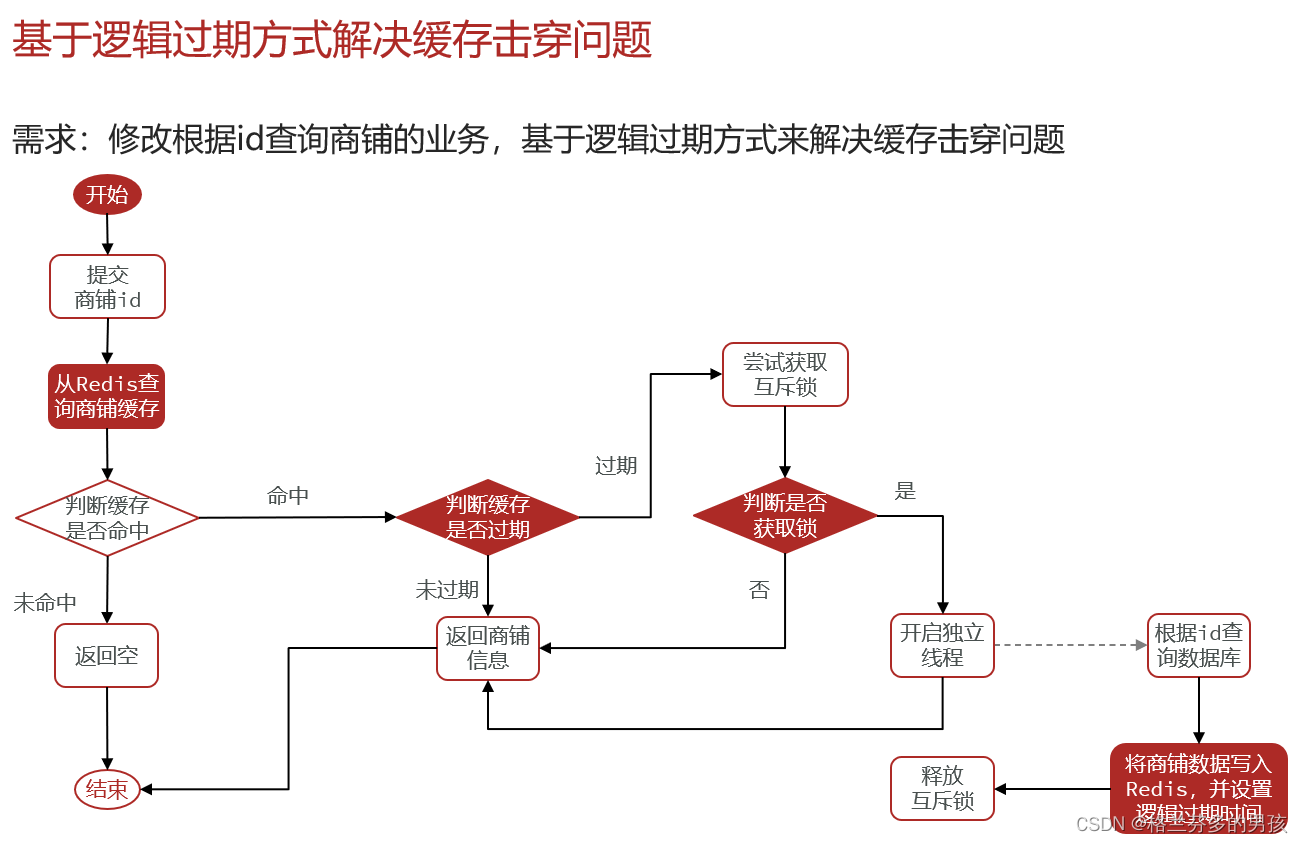
代码:
/**
* 创建线程池
*/
private static final ExecutorService CACHE_REBUILD_EXECUTOR = Executors.newFixedThreadPool(10);
/**
* 逻辑过期
*
* @param id
* @return
*/
public Shop queryWithLogicalExpire(Long id) {
String key = CACHE_SHOP_KEY + id;
//1.从redis查询商铺缓存
String shopJson = stringRedisTemplate.opsForValue().get(key);
//2.是否存在
if (StringUtil.isNullOrEmpty(shopJson)) {
//3.不存在 直接返回
return null;
}
//4.命中,需要先把json反序列化成对象
RedisData redisData = JSONUtil.toBean(shopJson, RedisData.class);
JSONObject data = (JSONObject) redisData.getData();
Shop shop = JSONUtil.toBean(data, Shop.class);
LocalDateTime expireTime = redisData.getExpireTime();
//5.判断是否过期
if (expireTime.isAfter(LocalDateTime.now())) {
//5.1未过期,直接返回店铺信息
return shop;
}
//5.2已过期
//6.缓存重建
String lockKye = LOCK_SHOP_KEY + id;
//6.1获取互斥锁
//6.2判断是否获取锁成功
boolean isLock = tryLock(lockKye);
if (isLock) {
//6.3成功开启,独立线程,实现缓存重建
CACHE_REBUILD_EXECUTOR.submit(() -> {
try {
// 重建缓存
this.saveShop2Redis(id, 20L);
} catch (Exception e) {
throw new RuntimeException(e);
} finally {
// 释放锁
unLock(lockKye);
}
});
}
//6.4返回过期店铺信息
return shop;
}
封装缓存工具类
基于StringRedisTemplate封装一个缓存工具类,满足下列需求:
方法1:将任意Java对象序列化为ison并存储在string类型的key中,并且可以设置TTL过期时间
方法2:将任意Java对象序列化为json并存储在string类型的key中,并且可以设置逻辑过期时间,用于处理缓存击穿问题
方法3:根据指定的key查询缓存,并反序列化为指定类型,利用缓存空值的方式解决缓存穿透问题
方法4:根据指定的key查询缓存,并反序列化为指定类型,需要利用逻辑过期解决缓存击穿问题
package com.hmdp.utils;
import cn.hutool.core.util.BooleanUtil;
import cn.hutool.json.JSONObject;
import cn.hutool.json.JSONUtil;
import com.hmdp.entity.Shop;
import io.netty.util.internal.StringUtil;
import lombok.extern.slf4j.Slf4j;
import org.springframework.data.redis.core.StringRedisTemplate;
import org.springframework.stereotype.Component;
import java.time.LocalDateTime;
import java.util.concurrent.ExecutorService;
import java.util.concurrent.Executors;
import java.util.concurrent.TimeUnit;
import java.util.function.Function;
import static com.hmdp.utils.RedisConstants.*;
@Slf4j
@Component
public class CacheClient {
private final StringRedisTemplate stringRedisTemplate;
public CacheClient(StringRedisTemplate stringRedisTemplate){
this.stringRedisTemplate = stringRedisTemplate;
}
/**
* 方法1:将任意Java对象序列化为ison并存储在string类型的key中,并且可以设置TTL过期时间
* 方法2:将任意Java对象序列化为json并存储在string类型的key中,并且可以设置逻辑过期时间,用于处理缓存击穿问题
* 方法3:根据指定的key查询缓存,并反序列化为指定类型,利用缓存空值的方式解决缓存穿透问题
* 方法4:根据指定的key查询缓存,并反序列化为指定类型,需要利用逻辑过期解决缓存击穿问题
*/
public void set(String key , Object value, Long time, TimeUnit unit){
stringRedisTemplate.opsForValue().set(key, JSONUtil.toJsonStr(value),time,unit);
}
public void setWithLogicalExpire(String key , Object value, Long time, TimeUnit unit){
//设置逻辑过期
RedisData redisData = new RedisData();
redisData.setData(value);
redisData.setExpireTime(LocalDateTime.now().plusSeconds(unit.toSeconds(time)));
//写入redis
stringRedisTemplate.opsForValue().set(key, JSONUtil.toJsonStr(redisData));
}
/**
* 缓存穿透
*
* @param id
* @return
*/
public <R,ID> R queryWithPassThrough(
String keyPrefix, ID id, Class<R> type, Function<ID,R> dbFallback,Long time, TimeUnit unit) {
String key = keyPrefix + id;
//1.从redis查询商铺缓存
String json = stringRedisTemplate.opsForValue().get(key);
//2.是否存在
if (!StringUtil.isNullOrEmpty(json)) {
//3.存在 返回商铺信息
R r = JSONUtil.toBean(json,type);
return r;
}
//判断命中的是否是空值
if (json != null) {
return null;
}
//4.不存在根据id在数据库中查询商铺信息
R r = dbFallback.apply(id);
//5.不存在 返回错误信息
if (r == null) {
stringRedisTemplate.opsForValue().set(key, "", CACHE_NULL_TTL, TimeUnit.MINUTES);
return null;
}
//6.存在 将商铺信息写入redis中 调用方法1
this.set(key,r,time,unit);
return r;
}
/**
* 创建线程池
*/
private static final ExecutorService CACHE_REBUILD_EXECUTOR = Executors.newFixedThreadPool(10);
/**
* 逻辑过期
*
* @param id
* @return
*/
public <R,ID> R queryWithLogicalExpire(String keyPrefix, ID id, Class<R> type, Function<ID,R> dbFallback,Long time, TimeUnit unit) {
String key = CACHE_SHOP_KEY + id;
//1.从redis查询商铺缓存
String shopJson = stringRedisTemplate.opsForValue().get(key);
//2.是否存在
if (StringUtil.isNullOrEmpty(shopJson)) {
//3.不存在 直接返回
return null;
}
//4.命中,需要先把json反序列化成对象
RedisData redisData = JSONUtil.toBean(shopJson, RedisData.class);
JSONObject data = (JSONObject) redisData.getData();
R r = JSONUtil.toBean(data, type);
LocalDateTime expireTime = redisData.getExpireTime();
//5.判断是否过期
if (expireTime.isAfter(LocalDateTime.now())) {
//5.1未过期,直接返回店铺信息
return r;
}
//5.2已过期
//6.缓存重建
String lockKye = LOCK_SHOP_KEY + id;
//6.1获取互斥锁
//6.2判断是否获取锁成功
boolean isLock = tryLock(lockKye);
if (isLock) {
//6.3成功开启,独立线程,实现缓存重建
CACHE_REBUILD_EXECUTOR.submit(() -> {
try {
//查询数据库
R r1 = dbFallback.apply(id);
//写入redis
setWithLogicalExpire(key,r1,time,unit);
} catch (Exception e) {
throw new RuntimeException(e);
} finally {
// 释放锁
unLock(lockKye);
}
});
}
//6.4返回过期店铺信息
return r;
}
/**
* 获取锁
*
* @param key
* @return
*/
private boolean tryLock(String key) {
Boolean flag = stringRedisTemplate.opsForValue().setIfAbsent(key, "1", 10, TimeUnit.SECONDS);
return BooleanUtil.isTrue(flag);
}
/**
* 释放锁
*
* @param key
* @return
*/
private void unLock(String key) {
stringRedisTemplate.delete(key);
}
}
项目源码
https://toscode.gitee.com/wanghuaiyu666/hm-dianping
欢迎大家到我的仓库下载项目源码
最后
以上就是清脆鸵鸟最近收集整理的关于Redis实战篇--商户查询缓存Redis实战篇–商户查询缓存的全部内容,更多相关Redis实战篇--商户查询缓存Redis实战篇–商户查询缓存内容请搜索靠谱客的其他文章。








发表评论 取消回复